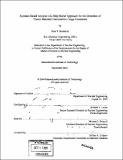| dc.contributor.advisor | Richard C. Lanza. | en_US |
| dc.contributor.author | Broderick, Brett P | en_US |
| dc.contributor.other | Massachusetts Institute of Technology. Dept. of Nuclear Engineering. | en_US |
| dc.date.accessioned | 2006-07-31T15:18:59Z | |
| dc.date.available | 2006-07-31T15:18:59Z | |
| dc.date.copyright | 2004 | en_US |
| dc.date.issued | 2004 | en_US |
| dc.identifier.uri | http://hdl.handle.net/1721.1/33636 | |
| dc.description | Thesis (S.M.)--Massachusetts Institute of Technology, Dept. of Nuclear Engineering, 2004. | en_US |
| dc.description | Includes bibliographical references (leaves 152-155). | en_US |
| dc.description.abstract | The international maritime container trade, which imports an average of 19,000 largely uninspected cargo containers to United States ports each day, has been identified as a potential avenue of attack for nuclear terrorism. Currently envisioned and deployed defensive measures that seek to detect and interdict concealed fissile material once containers have already reached a U.S. port do not adequately protect against nuclear threats due to the unique power and range of nuclear weapon effects. This thesis describes and examines a novel "ship-based" approach to container-borne fissile material detection where suites of radiation detectors with imaging capabilities are enclosed in standard, non-descript cargo containers and shipped in limited numbers aboard commercial containerships. Outfitted with communication hardware, these dedicated containerized units could provide crucial advance detection and notification of an inbound nuclear threat while the danger is still safely removed from U.S. shores. Attributes of the container shipping trade that would impact the performance and viability of the proposed ship-based approach were identified and investigated. | en_US |
| dc.description.abstract | (cont.) Average available count times, based on the duration of shipping voyages, for container imports to representative ports on the east and west coasts of the U.S. where found to be 19.2 days and 13.3. days, respectively. These long count times will enhance the ability of the ship- based approach to confidently detect heavily shielded and well-concealed fissile material. A distribution for the average distributed density of commercial cargo, which affects radiation attenuation between the source and detectors, was also derived and found to have a favorably low mean value of 0.198 g/cm³. The coverage efficiency (i.e. the number of containerized units required to provide detection coverage over a given percentage of a reference vessel) variations associated with prospective modes of deployment were also investigated using Matlab- based computer simulations. Evaluated deployment strategies ranged from fully random placement of detection units to completely constrained optimal placement. Despite holding important advantages in terms of stealth, random deployment was found to require an average of between 2.2 to 3.3 times more detectors than optimal deployment, depending on the desired level of detection coverage. | en_US |
| dc.description.abstract | (cont.) This result suggests that some combination of random and constrained deployment might yield an optimized balance between stealth and coverage efficiency. This analysis also identified significant efficiency and deployment flexibility benefits associated with units that could detect sources at ranges equal to, or greater than, 70 ft (21.3 m). Overall, no results were obtained that seriously challenged the potential efficacy and viability of the proposed ship-based approach. | en_US |
| dc.description.statementofresponsibility | by Brett P. Broderick. | en_US |
| dc.format.extent | 181 leaves | en_US |
| dc.format.extent | 19397298 bytes | |
| dc.format.extent | 19405003 bytes | |
| dc.format.mimetype | application/pdf | |
| dc.format.mimetype | application/pdf | |
| dc.language.iso | eng | en_US |
| dc.publisher | Massachusetts Institute of Technology | en_US |
| dc.rights | M.I.T. theses are protected by copyright. They may be viewed from this source for any purpose, but reproduction or distribution in any format is prohibited without written permission. See provided URL for inquiries about permission. | en_US |
| dc.rights.uri | http://dspace.mit.edu/handle/1721.1/7582 | |
| dc.subject | Nuclear Engineering. | en_US |
| dc.title | Systems-based analysis of a ship borne approach for the detection of fissile material concealed in cargo containers | en_US |
| dc.type | Thesis | en_US |
| dc.description.degree | S.M. | en_US |
| dc.contributor.department | Massachusetts Institute of Technology. Department of Nuclear Engineering | en_US |
| dc.contributor.department | Massachusetts Institute of Technology. Department of Nuclear Science and Engineering | |
| dc.identifier.oclc | 64393756 | en_US |
